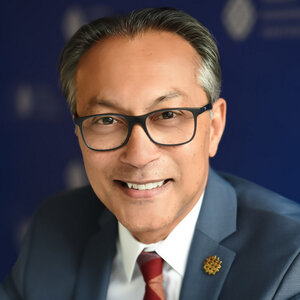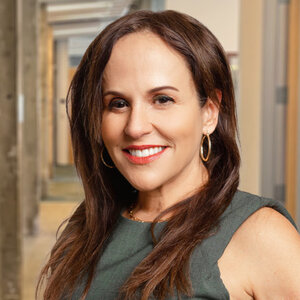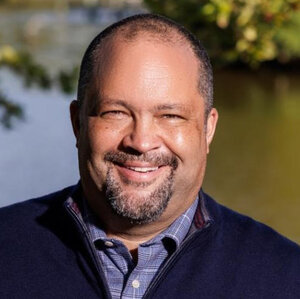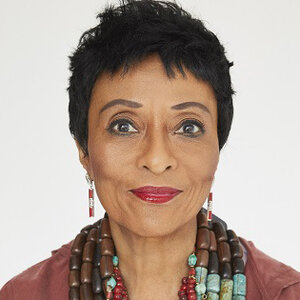Ani Dasgupta, President and CEO, World Resources Institute: Philanthropy’s opportunity to fill the gaps—and do it right
April 17, 2023
Recognized as a leader in the areas of sustainable cities, urban design, and poverty alleviation, Ani Dasgupta was appointed president and CEO of World Resources Institute (WRI) in 2021. He previously served for seven years as global director of WRI Ross Center for Sustainable Cities, where he created multi-stakeholder partnerships with city, national, and corporate leaders around the world. Prior to joining WRI in 2014, he served as director of knowledge and learning at the World Bank and as head of infrastructure in its Jakarta office, where he was deeply engaged in post-2004 tsunami reconstruction in Aceh.
Originally from Delhi, India, Dasgupta holds a bachelor’s degree in architecture, with an emphasis on low-income housing, from the School of Planning and Architecture and master's degrees from the Massachusetts Institute of Technology in city planning and architecture.
Philanthropy News Digest asked Dasgupta about the implications of the latest United Nations report on climate change, philanthropy’s role in mitigating the impacts, what a “just transition” to a climate-resilient future would require, and WRI’s new commitments to address water-related conflicts and strengthen water resilience in Africa.
Philanthropy News Digest: Among the key findings of the Intergovernmental Panel on Climate Change’s (IPCC) Sixth Assessment Report (AR6) is that “climate finance for both mitigation and adaptation must increase dramatically this decade.” In which areas of climate mitigation might philanthropy play a meaningful role?
Ani Dasgupta: Philanthropy has an incredible opportunity to work to fill the gaps—and do it right.
Right now, it’s clear the money isn’t flowing where it’s needed. For example, it’s not hard for entrepreneurs to get financing for renewable energy projects in countries like the United States or in Europe, especially with recent breakthroughs in government support. But these same projects are much more difficult to finance in the Global South. Borrowing costs are higher for investors, and these investments are often deemed risky. In 2020, the cost of capital for debt for the same project was 2 percent in the U.S. but 14 percent in Nigeria and 15 percent in Pakistan. At the same time, more and more countries in the Global South are constrained by debt crises. The financial system needs to shift in both the public and private sectors to make sure money flows towards climate mitigation and adaptation.
This is a place philanthropy could play a critical role. Take renewable energy, for example. Even though Africa has the world’s highest solar potential, investors are hesitant and government budgets are too stretched to fully explore and prioritize solar energy as the cheapest, fastest way to expand energy access in the region. Philanthropy is uniquely positioned to fill critical gaps like this and more, including financing the transition off coal, building capacity in governments, and supporting the policy changes needed for private capital to flow.
Philanthropy is uniquely positioned to fill critical gaps like...financing the transition off coal, building capacity in governments, and supporting the policy changes needed for private capital to flow.
PND: Another finding is that “adaptation measures can effectively build resilience, but more finance is needed to scale solutions.” What role do you see philanthropy playing in supporting ecosystem-based adaptation, for example? Where is it falling short?
AD: Philanthropy plays many essential roles in funding research and policy analysis, providing implementation funding, and driving some of the biggest breakthroughs in the climate and development space.
As we know, climate financing is lagging in general, but especially on adaptation. What we have found at WRI is that the most effective adaptation solutions are hyper-local. At the same time, a massive amount of capital needs to be invested across the world. So how do you get lots of capital into the hands of local communities everywhere? In our experience, a massive amount of innovation is needed, and this will look different in different parts of the world.
For example, after African countries pledged to restore 100 million hectares by 2030, we established TerraFund for AFR100 to provide small-scale grants and financing to local organizations and entrepreneurs to restore land. The benefits of local land restoration are clear and can provide up to $30 in benefits for every $1 invested. AFR100 (African Forest Landscape Restoration Initiative) showed that connecting hundreds of these projects with enough capital to implement them involves a massive amount of orchestration but is absolutely possible. Last year at COP27, SouthBridge Investments and the Arab Bank for Economic Development in Africa announced a $2 billion blended finance mechanism to support AFR100 in locally led restoration, and the Bezos Earth Fund announced $50 million in aligned philanthropic support for restoration.
This is where philanthropic funding can be catalytic. AFR100 is a perfect example of locally led adaptation being financed, implemented, and replicated across many places. But this is still not enough. It needs to be continuously replicated in different ways across the world.
PND: The IPCC report also found that changing course to limit global warming to 1.5°C (2.7°F) will require deep reductions in greenhouse gas emissions in the near term. The Greenhouse Gas Protocol, established by WRI and the World Business Council for Sustainable Development, provides the world’s most widely used greenhouse gas accounting standards and works with corporations, organizations, cities, and national governments to develop emissions reduction programs. What are the greatest challenges to achieving more significant reductions more quickly?
AD: The latest IPCC report makes it clear that the speed of the low-carbon transition needs to be faster than ever. The world needs to cut 2019 global emissions by 43 percent by 2030, but our own research finds that existing NDCs [nationally determined contributions] only reduce global emissions by 7 percent. The gap is immense. To fill it, we need to fundamental transform most countries’ economies.
The biggest and fastest change needed is to move away from fossil fuels. This needs to be a partnership of governments through policy, as well as businesses. Over 20 years ago, we started Greenhouse Gas Protocol with WBCSD to help businesses set targets and reduce emissions. Businesses are integral to not only reduce their own emissions but also to reduce the overall demand for fossil fuels.
The challenge of achieving significant emissions reductions is also that the whole system needs to change, across sectors and geographies. It’s hard because we can’t fix just one part of the problem.
The challenge of achieving significant emissions reductions is also that the whole system needs to change, across sectors and geographies. It’s hard because we can’t fix just one part of the problem. Our goal, which is shifting entire systems, requires a critical understanding of the individual parts, actors, and sectors and how they interact with each other.
PND: How do you define “a just transition” to a net-zero-emissions, climate-resilient future? What kinds of social programs might help reduce communities’ vulnerability to climate impacts, while strengthening justice and equity? Are governments adequately planning for such a transition?
AD: The concept of just transition is both simple and massively complex. It’s the idea that the transition into a low-carbon society—which we absolutely need—must be fair and inclusive. This is also a critical opportunity to bring benefits to people who have historically been left out or behind.
This requires real and deliberate action because even though a just transition promises to create over 65 million low-carbon jobs by 2030 according to the Global Commission on the Economy and Climate, moving away from fossil fuels is estimated to lead to at least six million jobs lost, mostly in the energy sector. Benefits and risks of the low-carbon transition will not be shared equitably unless governments are clear-eyed about the challenges they face.
Today, governments still need a lot more data about what jobs will be created or lost, where they will be, who they will go to, and what training is necessary to make the transition equitable. Right now, we don’t have the research needed to support a just transition away from fossil fuels.
Philanthropic capital can be helpful to get data infrastructure ready. In the U.S., President Biden’s Justice40 initiative is a great example of the political will needed not only to consider, but to mainstream, equity. We are working very closely with the U.S. on this and have seen that the government faces many challenges ensuring that the potential benefits of the transition go to the right people. Every country is still learning how to get the transition right, for people and the climate, and they need support to create and implement the policies that will make that happen.
PND: At the UN 2023 World Water Conference, WRI announced commitments to address water-related conflicts and strengthen water resilience in African cities through the Water, Peace, and Security Partnership and WRI’s Urban Water Resilience Initiative. Could you tell us a little about the latter’s blended public-private finance approach?
AD: Securing water for our societies by 2030 could cost just over 1 percent of global GDP. That’s a small investment for such incredible returns. But to reach our goals, we will need even more radical collaboration and collective ambition with finance to back it up.
The amazing thing about last month’s UN Water Conference was that it brought all the people working on the broad issue of water, from sanitation experts to policymakers looking to manage scarce water supplies to business leaders interested in building flood resilience, all together in one room. This sort of open discussion and collaboration is necessary to mobilize finance for successful implementation of solutions for a water-secure future.
Securing water for our societies by 2030 could cost just over 1 percent of global GDP. That’s a small investment for such incredible returns.
The new African Cities Water Adaptation (ACWA) Platform and Fund is a partnership that will offer technical assistance and financing to support 100 African cities in implementing 200 high-impact, low-carbon water solutions. Already, six African cities involved have made commitments to implement over 90 water resilience actions.
ACWA is looking to help transform early-stage plans into investment-ready projects. It is a one-stop shop, helping local leaders from the beginning to scope out projects and then structure deals, while also connecting them to grants and capital. We are using an integrated approach to bring together finance at scale, with the aim of leveraging $5 billion in financing. To leverage the private investment needed, the fund will blend grants and concessional loans from many sources—from philanthropy and development finance institutions to funds from the city and national governments from taxes and tariffs and more.
PND: Before joining WRI in 2014 as global director of WRI Ross Center for Sustainable Cities, you served as director of knowledge and learning at the World Bank. How does your experience in development finance inform your work at WRI? You also hold a bachelor’s degree in architecture, with an emphasis on low-income housing. How does your background in architecture inform your vision for a just transition for vulnerable communities?
AD: By the time I graduated from architecture school, I was very concerned about housing, especially housing in slums. I grew up in Delhi, and you can’t be raised there without being exposed to them. So, I felt my mission was to figure out how cities work and why there were slums in the first place. The first 20 years of my professional career was focused on multiple dimensions of urban poverty and cities in general.
One defining moment was a very destructive tsunami that destroyed the tip of Banda Aceh—a very populous city in Indonesia—that killed more than 250,000 people. After that disaster, there was a massive reconstruction program, and housing was a central part of it. I led the infrastructure reconstruction for the World Bank and partnered very closely with government of Indonesia and many other NGOs and bilaterals.
When reconstruction planning started, many people from other countries designed fancy prototypes for houses. My experience, having worked on poverty for a long time, was that houses are best built by people themselves—you just have to provide them the resources to build them, not build it for them. I did not think big contractors coming here and building houses was a good use of money, because it didn’t go to people. We needed to rebuild the local economy. And that’s what we did. If you go to Banda Aceh today, you probably won't even realize that it had suffered such a disaster.
I truly believe that for this transition to work, it must be good for people—because it will be impossible to decarbonize if a billion people who live in slums today continue to do so 10 years from now.
— Kyoko Uchida








Holistic, long-term thinking and action for the just transition we need